Potential Analysis and Optimal Management of Winter Electric Heating in Rural China Based on V2H Technology
Abstract
:1. Introduction
1.1. Background
1.2. Related Work
1.3. Motivation and Contribution
2. Microgrid Topology and Scenario Analysis
2.1. Microgrid Topology
2.2. Scenario Analysis of Electric Heating
- Step 1. Randomly select k data points as initial clustering centers;
- Step 2. Divide each data point by the nearest center of mass, measuring the distance between two sample data points;
- Step 3. Recalculate the center of mass of each cluster as the new cluster center, so that its total squared distance is minimized;
- Step 4. Repeat step 2 and step 3 until convergence.
3. The Bi-Layer Optimization Model
3.1. Upper-Layer Model
3.2. Lower-Layer Model
3.3. Methodology and Process of Solving
4. Case Study
4.1. Basic Data
4.2. Results and Analysis
4.3. Benefit Analysis
5. Conclusions
- (1)
- Analysis of the current situation and issues associated with the Coordinated to CtE project in Beijing. The study proposes a V2H-based system as an effective solution for addressing the issue of PV consumption and electric heating in rural areas of China.
- (2)
- To tackle the issue of dimensional explosion and the tendency to fall into local optima during the solution process, a bi-layer optimization model for energy management is proposed. The upper layer comprises a village-level microgrid energy-dispatching model aimed at fulfilling heating load demands. The lower layer focuses on a multi-vehicle energy allocation model that considers battery degradation.
- (3)
- The energy distribution results are obtained by solving the cases of typical and extreme conditions separately. In extreme weather, EVs store electrical energy one day in advance, which includes the transfer of electrical energy from vehicles that do not travel at night to vehicles that do travel, and the storage of electrical energy in vehicles that do not travel during the day. Under typical working conditions, the capacity of EVs as an energy storage device is sufficient when traveling is considered. EVs are able to complete the energy dissipation of PVs and release the electrical energy at night.
- (4)
- Optimization demonstrates substantial benefits, including a 45.9% reduction in the distribution capacity of the electric heating system based on V2H and PV power generation. Furthermore, residents can enjoy a significant reduction of 68.5% in their electricity bills. Additionally, the internal consumption of PV can be fully utilized.
Author Contributions
Funding
Institutional Review Board Statement
Informed Consent Statement
Data Availability Statement
Conflicts of Interest
Appendix A


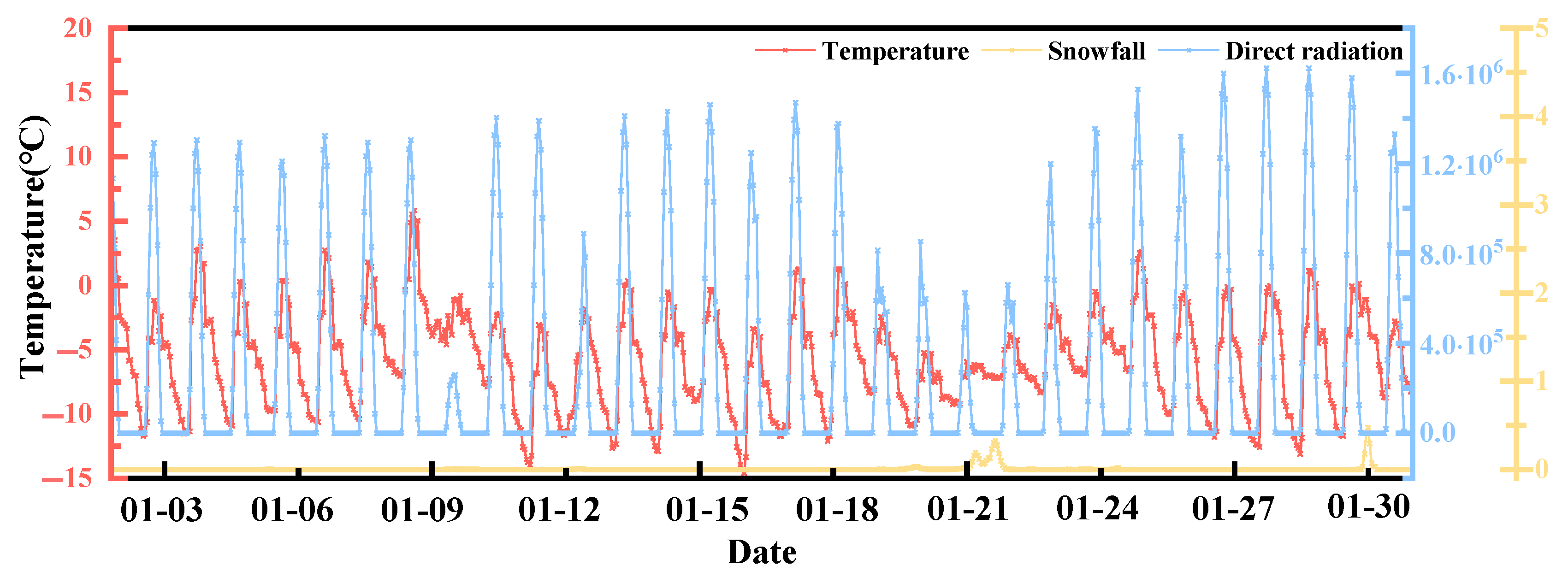
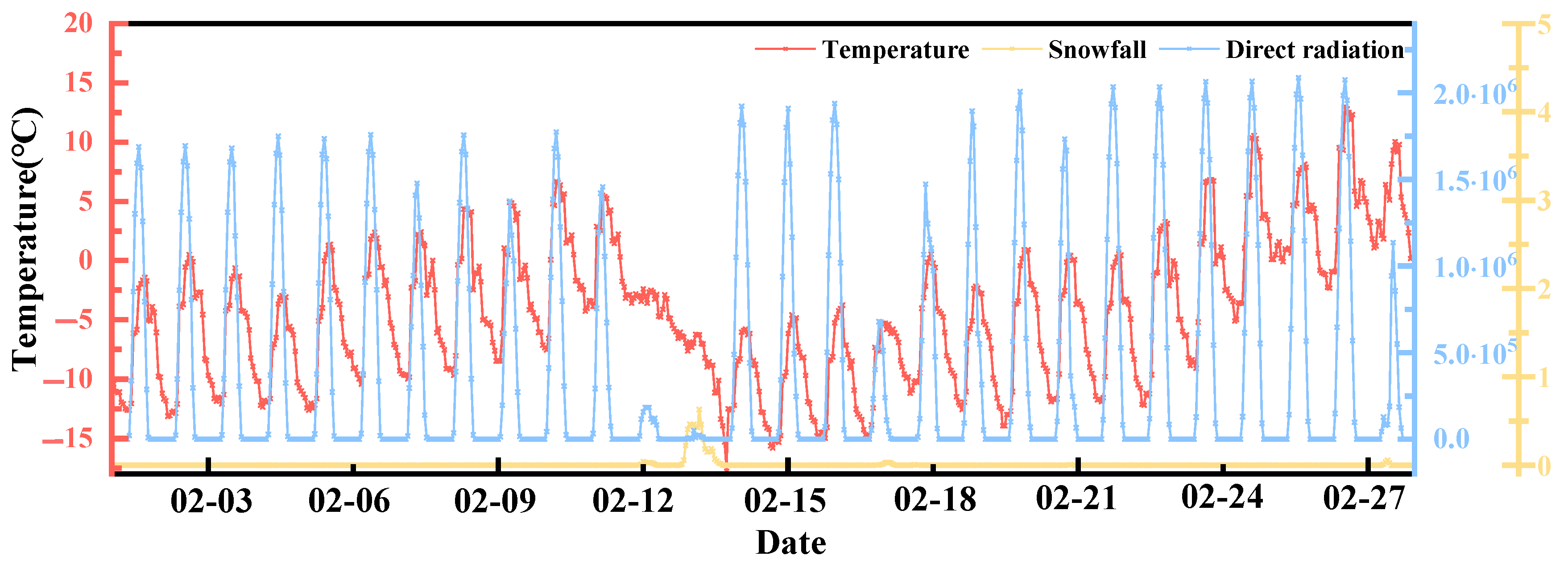

Appendix B

References
- Yu, W.; Guo, Y.; Shang, Z.; Zhang, Y.; Xu, S. A review on comprehensive recycling of spent power lithium-ion battery in China. eTransportation 2022, 11, 100155. [Google Scholar] [CrossRef]
- Stanaszek-Tomal, E. Anti-Smog Building and Civil Engineering Structures. Processes 2021, 9, 1446. [Google Scholar] [CrossRef]
- Cao, Z.; Zhao, L.; Meng, X.; Liu, X.; Wu, P.; Fan, X.; Wang, S.; Jie, J.; Miao, Z.; Xu, X.; et al. Amplification effect of haze on human exposure to halogenated flame retardants in atmospheric particulate matter and the corresponding mechanism. J. Hazard. Mater. 2018, 359, 491–499. [Google Scholar] [CrossRef] [PubMed]
- Sarswat, P.K.; Leake, M.; Allen, L.; Free, M.L.; Hu, X.; Kim, D.; Noble, A.; Luttrell, G.H. Efficient recovery of rare earth elements from coal based resources: A bioleaching approach. Mater. Today Chem. 2020, 16, 100246. [Google Scholar] [CrossRef]
- Cong, H.; Yao, Z.; Masek, O.; Meng, H.; Sheng, C.; Wu, Y.; Zhao, L. Co-combustion, co-densification, and pollutant emission characteristics of charcoal-based briquettes prepared using bio-tar as a binder. Fuel 2021, 287, 119512. [Google Scholar] [CrossRef]
- Tang, W.; Xu, Z.; Shan, B.; Zhang, Y.; Wu, P.; Jia, Y.; Zhang, C.; Tan, Q. Electric Energy Substitution Planning for the “14th Five-Year Plan” Period Based on Characteristics of Energy Consumption Structure of Subdivided Industries. Electr. Power 2021, 54, 36–45. [Google Scholar]
- Guo, X.; Guo, X.; Yuan, J. Impact Analysis of Air Pollutant Emission Policies on Thermal Coal Supply Chain Enterprises in China. Sustainability 2015, 7, 75–95. [Google Scholar] [CrossRef] [Green Version]
- Du, Y.; Ma, T. Impact of electricity pricing strategy on residential energy consumption decisions in China: Empirical evidence from a household survey. J. Environ. Econ. Policy 2022, 11, 154–171. [Google Scholar] [CrossRef]
- Yang, X.; Doyle-Davis, K.; Gao, X.; Sun, X. Recent progress and perspectives on designing high-performance thick electrodes for all-solid-state lithium batteries. eTransportation 2022, 11, 100152. [Google Scholar] [CrossRef]
- Zhang, X.; Wang, B.; Zhao, S.; Li, H.; Yu, H. Oxygen anionic redox activated high-energy cathodes: Status and prospects. eTransportation 2021, 8, 100118. [Google Scholar] [CrossRef]
- Siqi, C.; Xuezhe, W.; Guangxu, Z.; Xueyuan, W.; Jiangong, Z.; Xuning, F.; Haifeng, D.; Minggao, O. All-temperature-area battery application mechanism, performance and strategies. Innovation 2023, 4, 100465. [Google Scholar] [CrossRef]
- Chen, S.; Zhang, G.; Wu, C.; Huang, W.; Xu, C.; Jin, C.; Wu, Y.; Jiang, Z.; Dai, H.; Feng, X.; et al. Multi-objective optimization design for a double-direction liquid heating system-based Cell-to-Chassis battery module. Int. J. Heat Mass Transf. 2022, 183, 122184. [Google Scholar] [CrossRef]
- Chen, S.; Zhang, G.; Zhu, J.; Feng, X.; Wei, X.; Ouyang, M.; Dai, H. Multi-objective optimization design and experimental investigation for a parallel liquid cooling-based Lithium-ion battery module under fast charging. Appl. Therm. Eng. 2022, 211, 118503. [Google Scholar] [CrossRef]
- Yang, Z.; Li, Q.; Yan, Y.; Shang, W.-L.; Ochieng, W. Examining influence factors of Chinese electric vehicle market demand based on online reviews under moderating effect of subsidy policy. Appl. Energy 2022, 326, 120019. [Google Scholar] [CrossRef]
- Chen, Y.; Xia, D. Systematic density functional theory investigations on cubic lithium-rich iron-based Li2FeO3: A multiple electrons cationic and anionic redox cathode material. eTransportation 2021, 10, 100141. [Google Scholar] [CrossRef]
- Venegas, F.G.; Petit, M.; Perez, Y. Plug-in behavior of electric vehicles users: Insights from a large-scale trial and impacts for grid integration studies. eTransportation 2021, 10, 100131. [Google Scholar] [CrossRef]
- Kempton, W.; Tomic, J. Vehicle-to-grid power fundamentals: Calculating capacity and net revenue. J. Power Sources 2005, 144, 268–279. [Google Scholar] [CrossRef]
- Li, Y.; Han, X.; Feng, X.; Chu, Z.; Gao, X.; Li, R.; Du, J.; Lu, L.; Ouyang, M. Errors in the reference electrode measurements in real lithium-ion batteries. J. Power Sources 2021, 481, 228933. [Google Scholar] [CrossRef]
- Li, Y.; Wei, Y.; Zhu, F.; Du, J.; Zhao, Z.; Ouyang, M. The path enabling storage of renewable energy toward carbon neutralization in China. eTransportation 2023, 16, 100226. [Google Scholar] [CrossRef]
- Schmidt, S. Use of battery swapping for improving environmental balance and price-performance ratio of electric vehicles. eTransportation 2021, 9, 100128. [Google Scholar] [CrossRef]
- Hussain, M.A.; Brandauer, W.; Lee, M.J. Mobility-Aware Vehicle-to-Grid (V2G) Optimization for Uniform Utilization in Smart Grid Based Power Distribution Network. Mob. Netw. Appl. 2019, 24, 1701–1712. [Google Scholar] [CrossRef]
- Qiu, D.; Wang, Y.; Hua, W.; Strbac, G. Reinforcement learning for electric vehicle applications in power systems: A critical review. Renew. Sustain. Energy Rev. 2023, 173, 113052. [Google Scholar] [CrossRef]
- Dixon, J.; Bukhsh, W.; Bell, K.; Brand, C. Vehicle to grid: Driver plug-in patterns, their impact on the cost and carbon of charging, and implications for system flexibility. eTransportation 2022, 13, 100180. [Google Scholar] [CrossRef]
- Çeçen, M.; Yavuz, C.; Tırmıkçı, C.A.; Sarıkaya, S.; Yanıkoğlu, E. Analysis and evaluation of distributed photovoltaic generation in electrical energy production and related regulations of Turkey. Clean Technol. Environ. Policy 2022, 24, 1321–1336. [Google Scholar] [CrossRef] [PubMed]
- Saldaña, G.; Ignacio San Martin, J.; Zamora, I.; Javier Asensio, F.; Oñederra, O. Electric Vehicle into the Grid: Charging Methodologies Aimed at Providing Ancillary Services Considering Battery Degradation. Energies 2019, 12, 2443. [Google Scholar] [CrossRef] [Green Version]
- Hutty, T.D.; Pena-Bello, A.; Dong, S.; Parra, D.; Rothman, R.; Brown, S. Peer-to-peer electricity trading as an enabler of increased PV and EV ownership. Energy Convers. Management. 2021, 245, 114634. [Google Scholar] [CrossRef]
- Long, G.; Qiu, M.; Wang, S.; Li, L.; Ma, K. The Evaluation of Electric Heating Load Construction Based on Renewable Energy Generation for Coal-to-Electricity Project. In Proceedings of the IEEE Conference on Energy Internet and Energy System Integration (EI2), Beijing, China, 26–28 November 2017. [Google Scholar]
- Li, Y.; Liu, M.; Tang, Y.; Jia, Y.; Wang, Q.; Ma, Q.; Hong, J.; Zuo, J.; Yuan, X. Life cycle impact of winter heating in rural China from the perspective of environment, economy, and user experience. Energy Convers. Manag. 2022, 269, 116156. [Google Scholar] [CrossRef]
- Su, C.; Madani, H.; Palm, B. Building heating solutions in China: A spatial techno-economic and environmental analysis. Energy Convers. Manag. 2019, 179, 201–218. [Google Scholar]
- Zhang, R.; Wang, G.; Shen, X.; Wang, J.; Tan, X.; Feng, S.; Hong, J. Is geothermal heating environmentally superior than coal fired heating in China? Renew. Sustain. Energy Rev. 2020, 131, 110014. [Google Scholar] [CrossRef]
- Zhang, C.; Yang, J. Economic benefits assessments of "coal-to-electricity" project in rural residents heating based on life cycle cost. J. Clean. Prod. 2019, 213, 217–224. [Google Scholar]
- Hu, Y.; Zhang, M.; Wang, K.; Wang, D. Optimization of orderly charging strategy of electric vehicle based on improved alternating direction method of multipliers. J. Energy Storage 2022, 55, 105483. [Google Scholar] [CrossRef]
- Wei, Y.; Han, T.; Wang, S.; Qin, Y.; Lu, L.; Han, X.; Ouyang, M. An efficient data-driven optimal sizing framework for photovoltaics-battery-based electric vehicle charging microgrid. J. Energy Storage 2022, 55, 105670. [Google Scholar] [CrossRef]
- Tookanlou, M.B.; Kani, S.A.P.; Marzband, M. A comprehensive day-ahead scheduling strategy for electric vehicles operation. Int. J. Electr. Power Energy Syst. 2021, 131, 106912. [Google Scholar] [CrossRef]
- Daramola, A.S.; Ahmadi, S.E.; Marzband, M.; Ikpehai, A. A cost-effective and ecological stochastic optimization for integration of distributed energy resources in energy networks considering vehicle-to-grid and combined heat and power technologies. J. Energy Storage 2023, 57, 106203. [Google Scholar] [CrossRef]
- Huang, S.J.; Wu, Q.W. Dynamic Tariff-Subsidy Method for PV and V2G Congestion Management in Distribution Networks. IEEE Trans. Smart Grid 2019, 10, 5851–5860. [Google Scholar] [CrossRef] [Green Version]
- Wang, Z.; Tang, Y.; Chen, X.; Men, X.; Cao, J.; Wang, H. Optimized Daily Dispatching Strategy of Building-Integrated Energy Systems Considering Vehicle to Grid Technology and Room Temperature Control. Energies 2018, 11, 1287. [Google Scholar] [CrossRef] [Green Version]
- Zhang, Q.; Dehghanpour, K.; Wang, Z.; Huang, Q. A Learning-Based Power Management Method for Networked Microgrids Under Incomplete Information. IEEE Trans. Smart Grid 2020, 11, 1193–1204. [Google Scholar] [CrossRef] [Green Version]
- Wang, Y.; Zhang, N.; Chen, Q.; Kirschen, D.S.; Li, P.; Xia, Q. Data-Driven Probabilistic Net Load Forecasting With High Penetration of Behind-the-Meter PV. IEEE Trans. Power Syst. 2018, 33, 3255–3264. [Google Scholar] [CrossRef]
- Chen, G.; Zhang, H.; Hui, H.; Dai, N.; Song, Y. Scheduling Thermostatically Controlled Loads to Provide Regulation Capacity Based on a Learning-Based Optimal Power Flow Model. IEEE Trans. Sustain. Energy 2021, 12, 2459–2470. [Google Scholar] [CrossRef]
- Elkadeem, M.R.; Wang, S.; Sharshir, S.W.; Atia, E.G. Feasibility analysis and techno-economic design of grid-isolated hybrid renewable energy system for electrification of agriculture and irrigation area: A case study in Dongola, Sudan. Energy Convers. Manag. 2019, 196, 1453–1478. [Google Scholar] [CrossRef]
- Dong, W.; Yang, Q.; Fang, X.; Ruan, W. Adaptive optimal fuzzy logic based energy management in multi-energy microgrid considering operational uncertainties. Appl. Soft. Comput. 2021, 98, 106882. [Google Scholar] [CrossRef]
- Camargo Nogueira, C.E.; Vidotto, M.L.; Niedzialkoski, R.K.; Melegari de Souza, S.N.; Chaves, L.I.; Edwiges, T.; dos Santos, D.B.; Werncke, I. Sizing and simulation of a photovoltaic-wind energy system using batteries, applied for a small rural property located in the south of Brazil. Renew. Sustain. Energy Rev. 2014, 29, 151–157. [Google Scholar] [CrossRef]
- Cardoso, G.; Brouhard, T.; DeForest, N.; Wang, D.; Heleno, M.; Kotzur, L. Battery aging in multi-energy microgrid design using mixed integer linear programming. Appl. Energy 2018, 231, 1059–1069. [Google Scholar] [CrossRef]
- Fossati, J.P.; Galarza, A.; Martín-Villate, A.; Fontán, L. A method for optimal sizing energy storage systems for microgrids. Renew. Energy 2015, 77, 539–549. [Google Scholar] [CrossRef]
- Sanchez, V.M.; Chavez-Ramirez, A.U.; Duron-Torres, S.M.; Hernandez, J.; Arriaga, L.G.; Ramirez, J.M. Techno-economical optimization based on swarm intelligence algorithm for a stand-alone wind-photovoltaic-hydrogen power system at south-east region of Mexico. Int. J. Hydrog. Energy 2014, 39, 16646–16655. [Google Scholar] [CrossRef]
- Yuan, G.; Wang, H.; Khazaei, E.; Khan, B. Collaborative advanced machine learning techniques in optimal energy management of hybrid AC/DC IoT-based microgrids. Ad Hoc Netw. 2021, 122, 102657. [Google Scholar] [CrossRef]
- Fan, L.; Xiong, Z. Using Quantile Regression to Detect Relationships between Large-scale Predictors and Local Precipitation over Northern China. Adv. Atmos. Sci. 2015, 32, 541–552. [Google Scholar] [CrossRef]
- Ji, W.; Wang, Y.; Zhuang, D. Spatial distribution differences in PM2.5 concentration between heating and non-heating seasons in Beijing, China. Environ. Pollut. 2019, 248, 574–583. [Google Scholar] [CrossRef]
- Govender, P.; Sivakumar, V. Application of k-means and hierarchical clustering techniques for analysis of air pollution: A review (1980–2019). Atmos. Pollut. Res. 2020, 11, 40–56. [Google Scholar] [CrossRef]
- Aggarwal, S.; Singh, P. Cuckoo, Bat and Krill Herd based k-means++ clustering algorithms. Clust. Comput. 2019, 22, 14169–14180. [Google Scholar] [CrossRef]
- Zeng, N.; Wang, Z.; Liu, W.; Zhang, H.; Hone, K.; Liu, X. A Dynamic Neighborhood-Based Switching Particle Swarm Optimization Algorithm. IEEE Trans. Cybern. 2022, 52, 9290–9301. [Google Scholar] [CrossRef] [PubMed]
- Johnston, I.G.; Dingle, K.; Greenbury, S.F.; Camargo, C.Q.; Doye, J.P.K.; Ahnert, S.E.; Louis, A.A. Symmetry and simplicity spontaneously emerge from the algorithmic nature of evolution. Biophys. Comput. Biol. 2022, 119, e2113883119. [Google Scholar] [CrossRef] [PubMed]
- Beijing Institute of Transportation Development. Beijing Transport Development Annual Report. Available online: https://www.bjtrc.org.cn/List/index/cid/7.html (accessed on 30 June 2023).
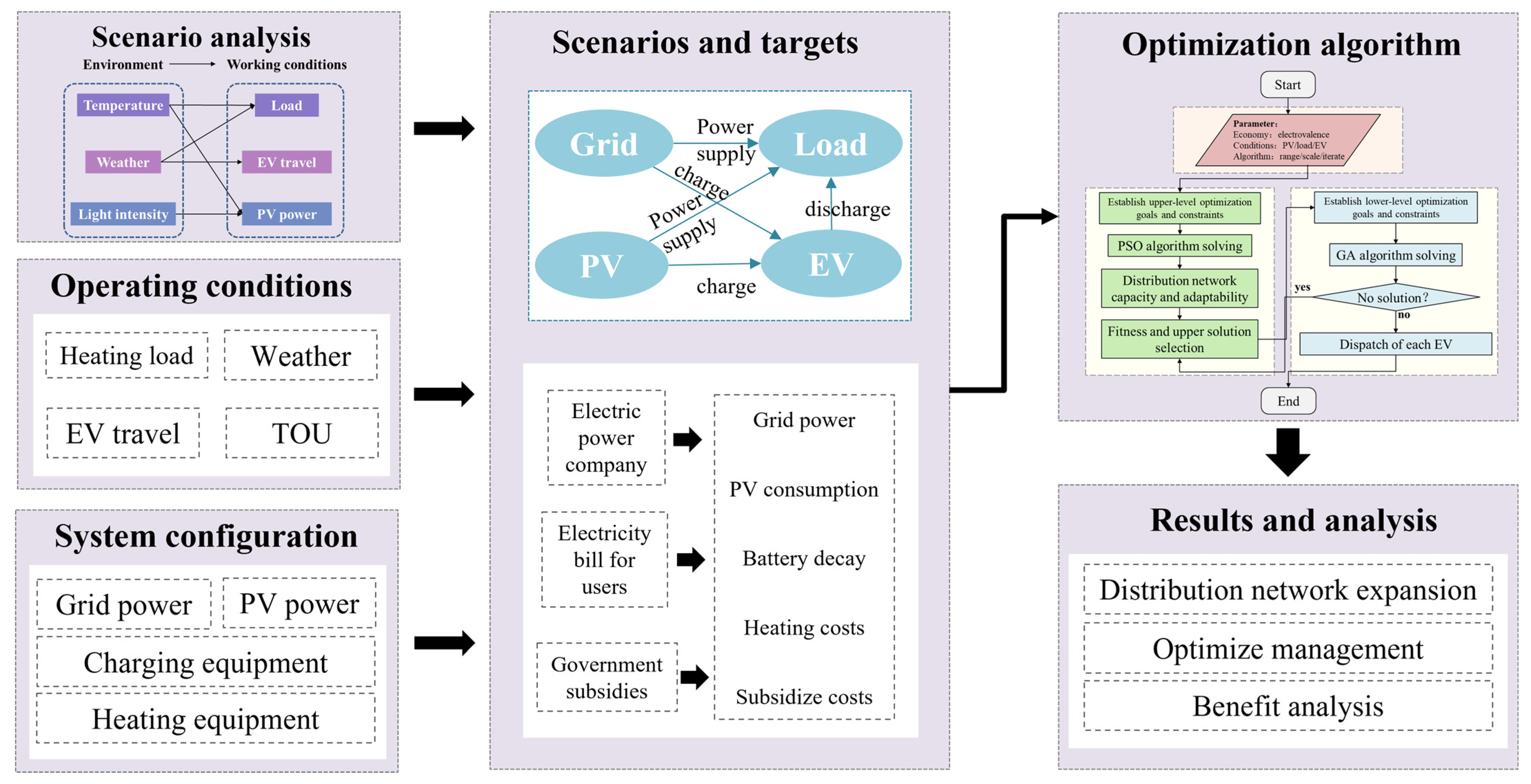
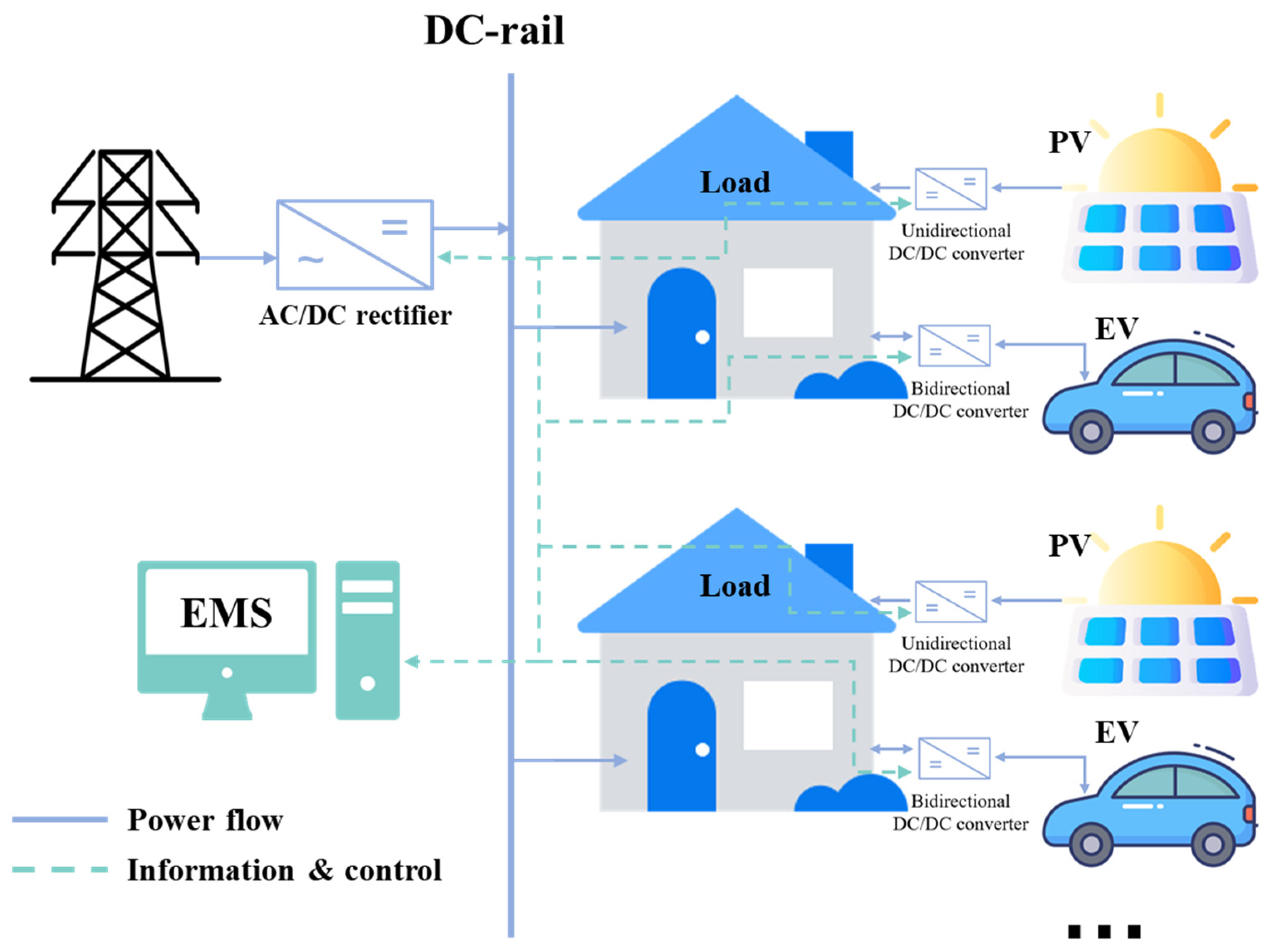




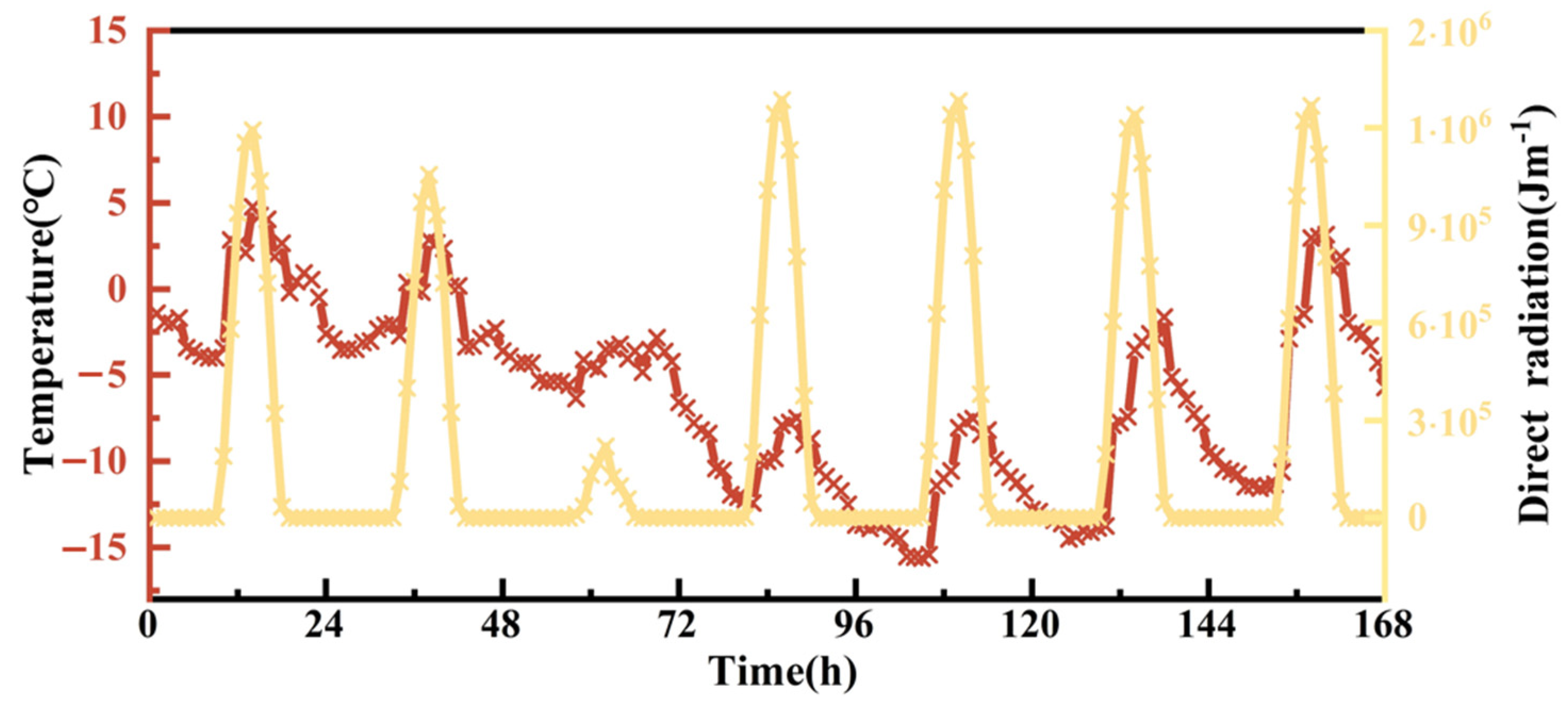

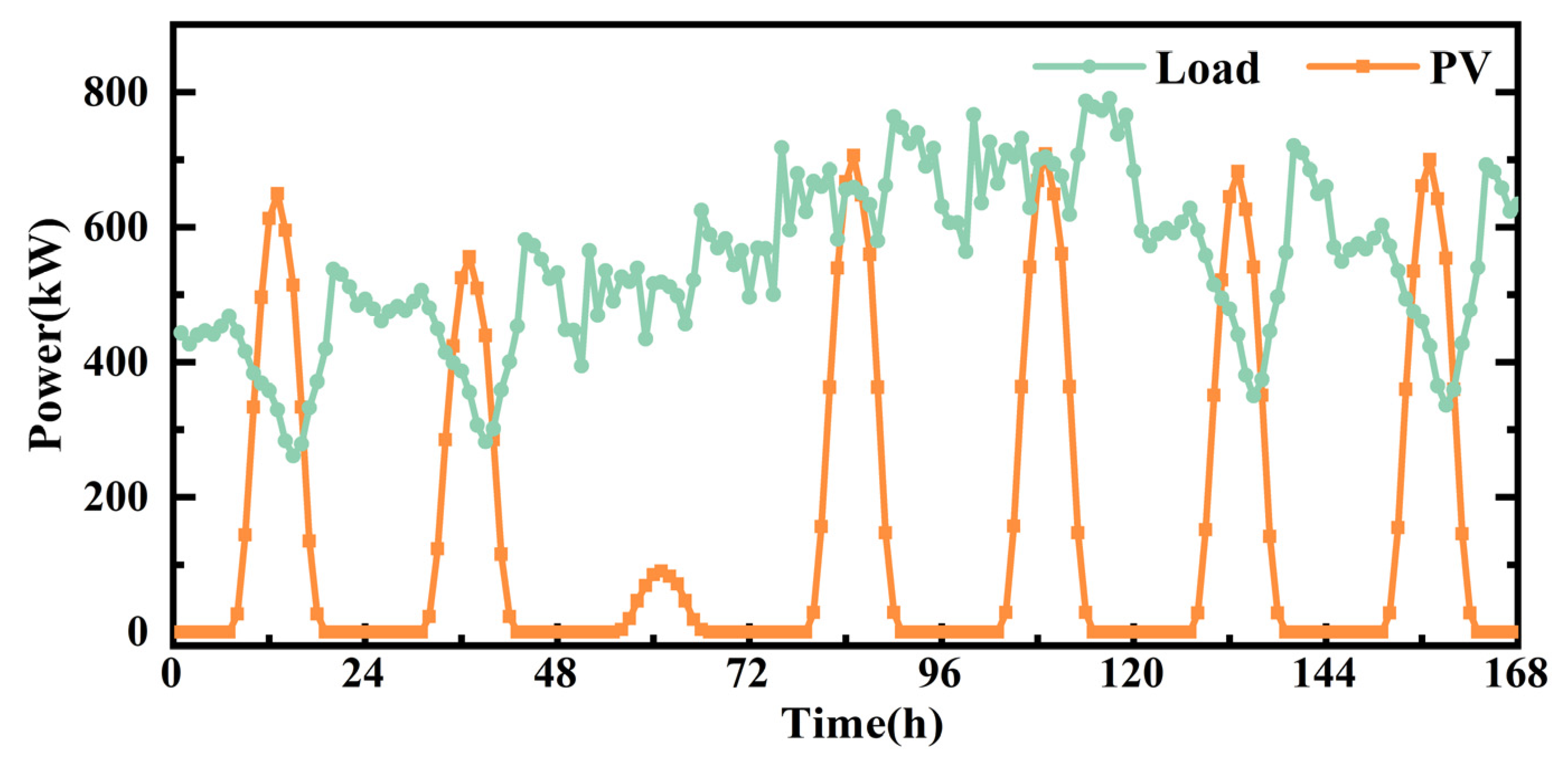
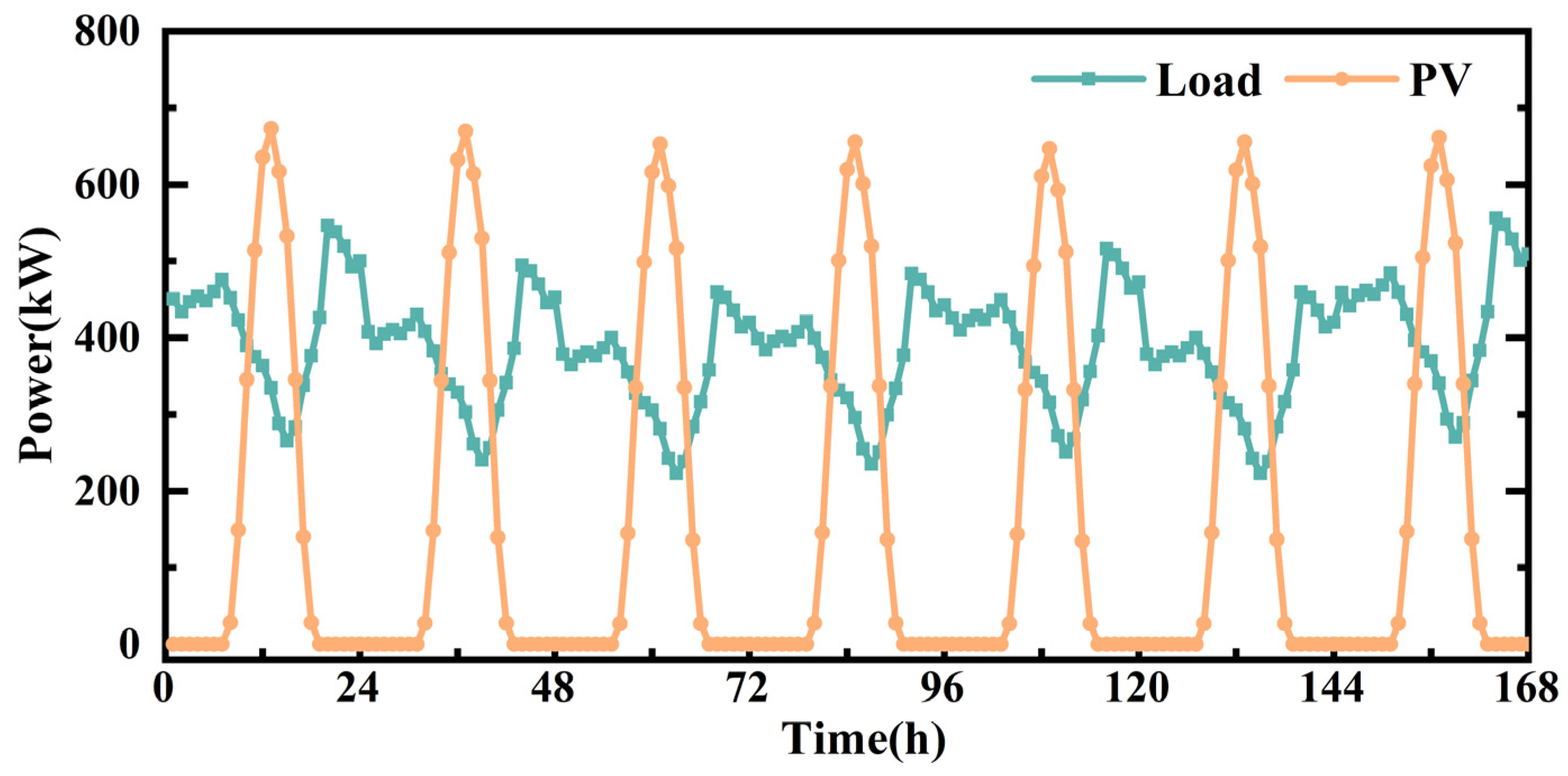


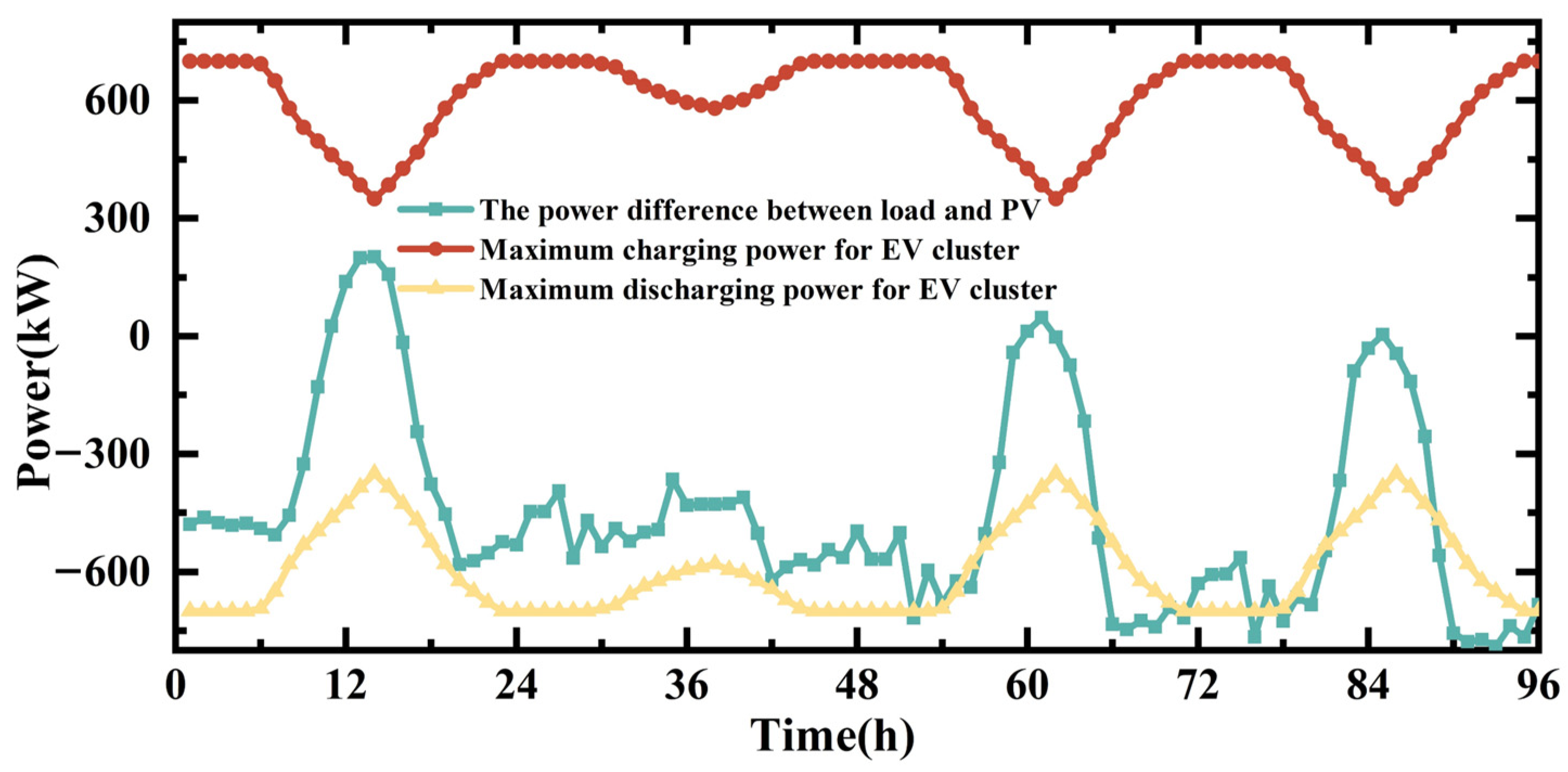
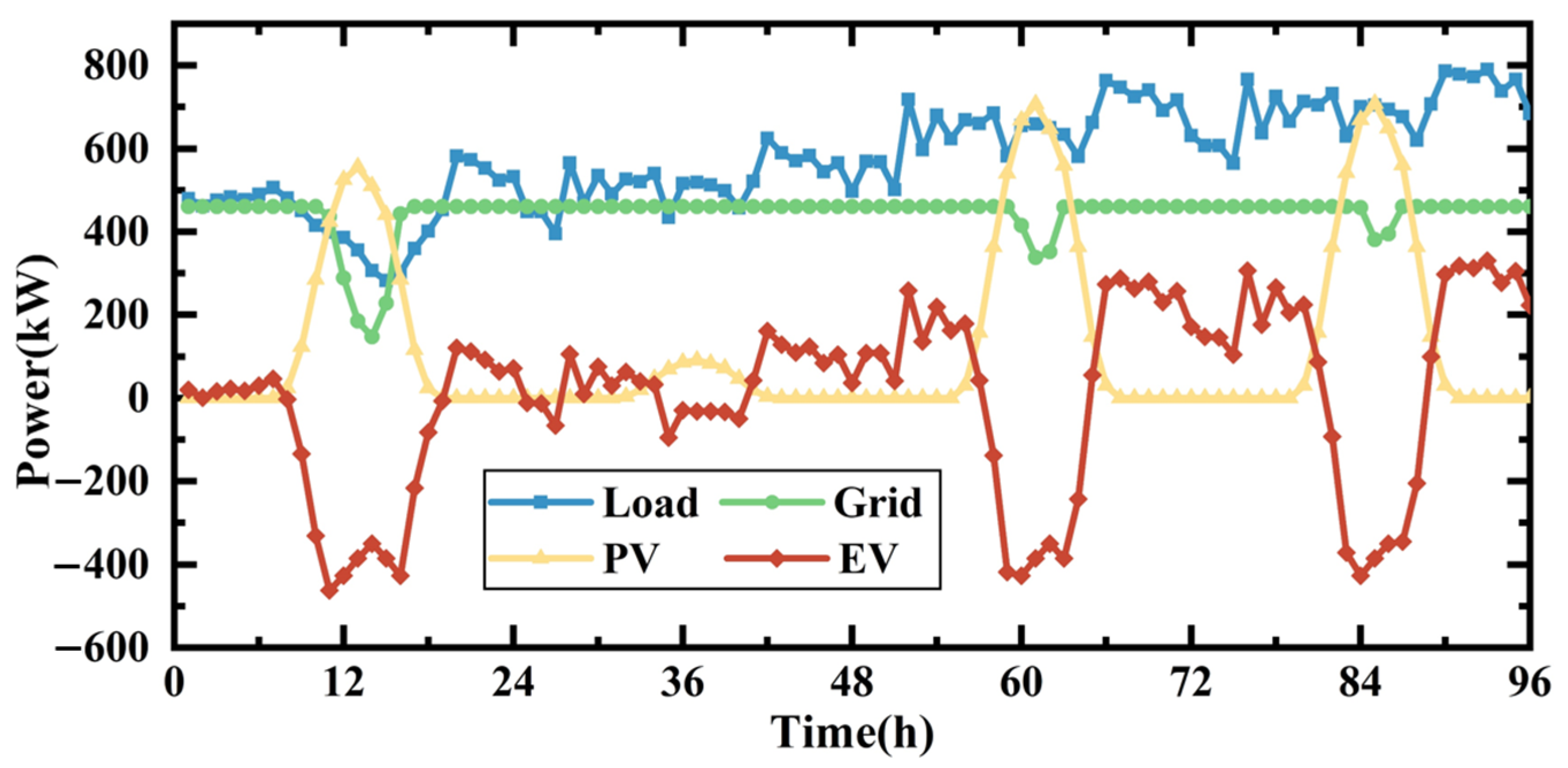
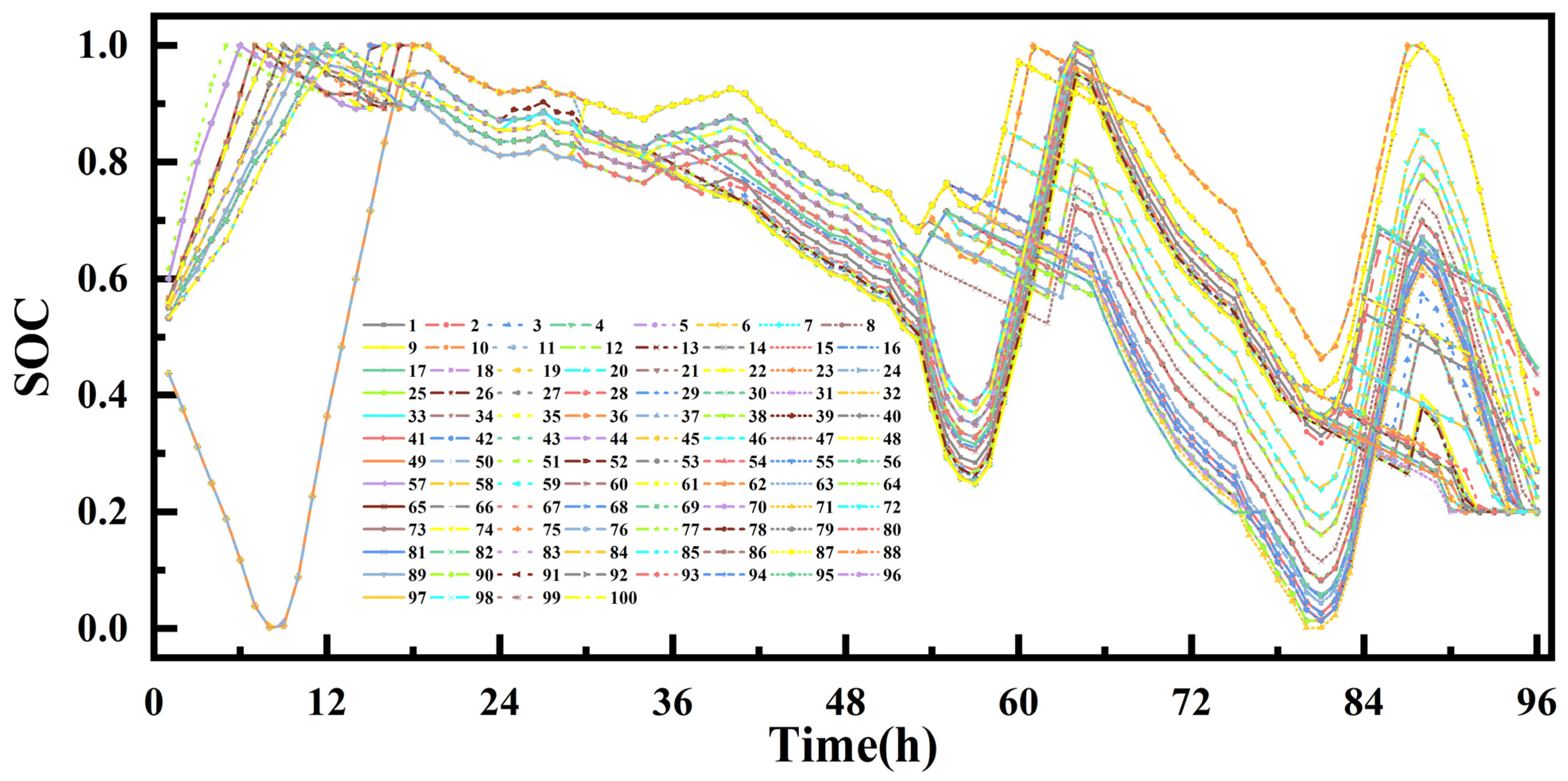

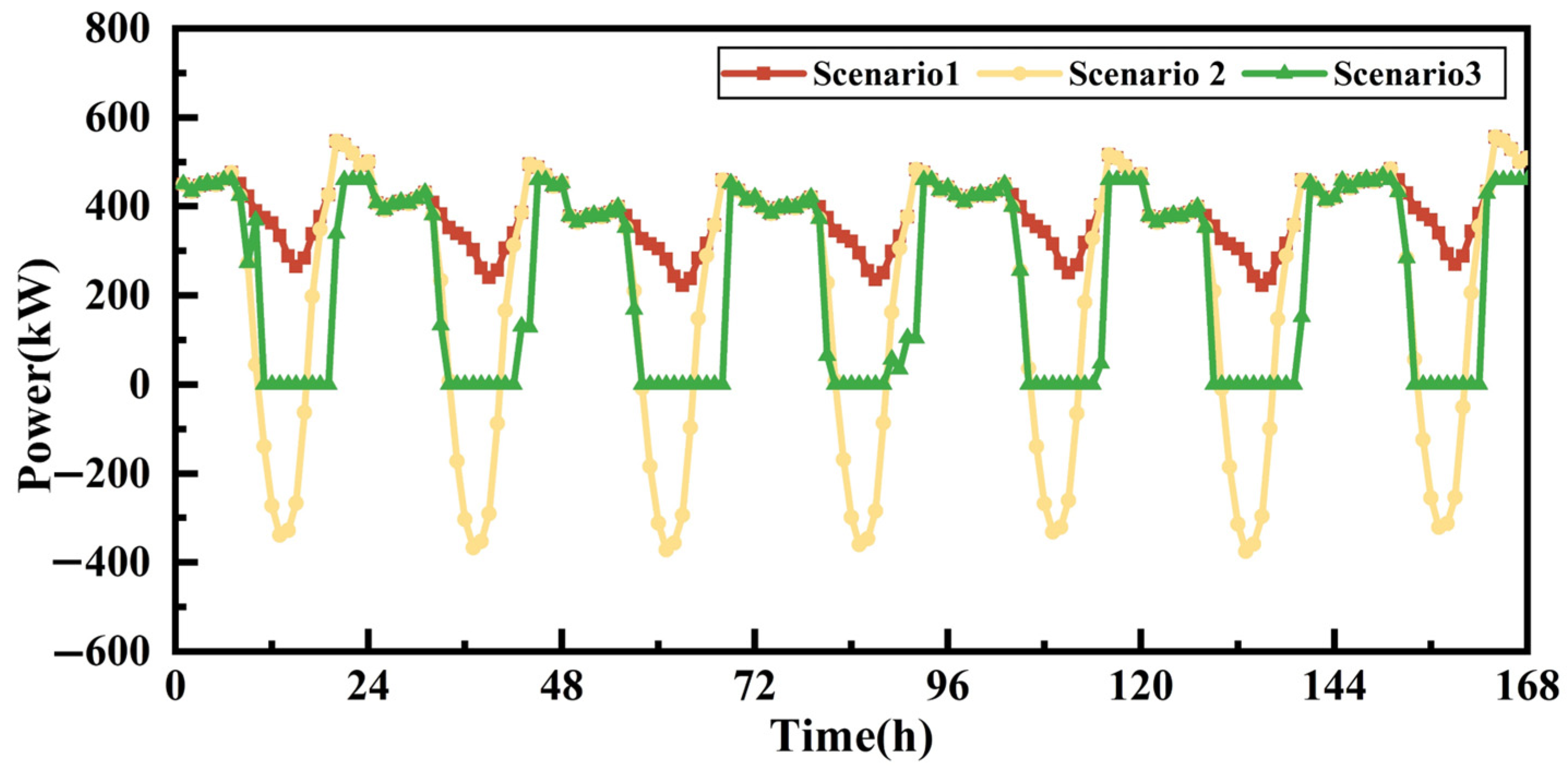

| Cold Weather | Warm Weather | |
|---|---|---|
| Average temperature | −2.74 | 5.69 |
| Highest temperature | 3.2 | 12.3 |
| Lowest Temperature | −8.7 | −0.9 |
| Cold Weather | General Weather | Warm Weather | |
|---|---|---|---|
| Average temperature | −3.06 | 2.61 | 8.14 |
| Highest temperature | 2.6 | 9.9 | 14.2 |
| Lowest Temperature | −8.9 | −3.7 | 1.1 |
| Parameters | Value |
|---|---|
| Photovoltaic capacity per household (kW) | 12.7 |
| Maximum EV charging power (kW) | 7 |
| EV battery capacity (kWh) | 60 |
| SOC upper boundary of the EV (%) | 100 |
| SOC lower boundary of the EV (%) | 0 |
| Number of residential households | 100 |
Disclaimer/Publisher’s Note: The statements, opinions and data contained in all publications are solely those of the individual author(s) and contributor(s) and not of MDPI and/or the editor(s). MDPI and/or the editor(s) disclaim responsibility for any injury to people or property resulting from any ideas, methods, instructions or products referred to in the content. |
© 2023 by the authors. Licensee MDPI, Basel, Switzerland. This article is an open access article distributed under the terms and conditions of the Creative Commons Attribution (CC BY) license (https://creativecommons.org/licenses/by/4.0/).
Share and Cite
Gao, X.; Li, R.; Chen, S.; Li, Y. Potential Analysis and Optimal Management of Winter Electric Heating in Rural China Based on V2H Technology. Sustainability 2023, 15, 11517. https://doi.org/10.3390/su151511517
Gao X, Li R, Chen S, Li Y. Potential Analysis and Optimal Management of Winter Electric Heating in Rural China Based on V2H Technology. Sustainability. 2023; 15(15):11517. https://doi.org/10.3390/su151511517
Chicago/Turabian StyleGao, Xinjia, Ran Li, Siqi Chen, and Yalun Li. 2023. "Potential Analysis and Optimal Management of Winter Electric Heating in Rural China Based on V2H Technology" Sustainability 15, no. 15: 11517. https://doi.org/10.3390/su151511517
APA StyleGao, X., Li, R., Chen, S., & Li, Y. (2023). Potential Analysis and Optimal Management of Winter Electric Heating in Rural China Based on V2H Technology. Sustainability, 15(15), 11517. https://doi.org/10.3390/su151511517









